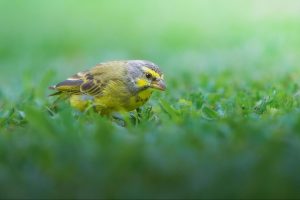More
Top 5 Domestic SongBirds

What is a songbird? What are the most popular domestic singing birds? Which songbird to adopt? What are the best songbirds? Songbirds are known to be very sociable and affectionate, making them extremely popular companions for humans. These birds emit highly vocalized sounds that are generally associated with songs. As a result, the cries of these songbirds are pleasant to listen to.
Singing Birds to Adopt
If you like birdsong, some species of birds are better singers than others. We will help you find the ideal domestic songbird for you.
We invite you to discover 5 species of songbirds popular as pets:
- The Canary.
- The Mozambique Serin.
- The Goldfinch Mule.
- The Japanese Nightingale.
- The diamond.
These are singing birds with fascinating intelligence, but also great beauty. Discover the best domestic singing birds and their songs.
Please note, although these pet birds have indisputable qualities, adopting a songbird is a very complex commitment. Like any pet, these birds require a lot of care and attention. It is also necessary to have a place where these birds can sing at their convenience.
Note also that the breeding of songbirds is extremely regulated. To acquire certain species, it is mandatory to obtain a prefectural possession authorization. Discover the list of the most popular domestic songbirds.
The songbird 1: The Canary

The canary is certainly the most common species of songbird. When it designates a group of songbirds, having the Saxons as their common origin, the Canary is made up of two breeds: the Harz Canary and the Malinois Canary.
Physical characteristics of the Harz Canary
The Harz canary is a medium-sized bird measuring an average of 14 cm. The color of its plumage varies from yellow to green. Only male canaries sing, while females chirp.
Life expectancy of the Harz Canary
The life expectancy of the Harz Canary is 10 years on average.
The singing technique of the Harz Canary
The Harz Canary generally sings with its beak closed. Its song is composed of rolling and deep sounds, very harmonious.
Physical Characteristics of the Malinois Canary
Unlike the Harz Canary, the Malinois Canary is large. It measures on average 15 to 17 cm. Yellow to pale yellow in color, it is said to be robust and lively, but also very easy to raise.
Life expectancy of the Malinois Canary
The life expectancy of the Malinois Canary fluctuates, on average, between 8 and 10 years.
The Malinois Canary singing technique
Tireless when it comes to participating in the musical ambiance, his singing closely resembles the sound of running water.
The songbird 2: The Mozambique Serin

The Mozambique Serin is an excellent songbird as well as a very good companion. Originally from the Sahara, this songbird lives in sparse forests as well as savannahs. Despite its name “canary”, it is actually a species of finch.
Physical characteristics of the Mozambique Serin
The Mozambique Serin is a robust bird whose size varies from 11 to 12 cm. There are around ten subspecies whose color shades vary.
Life expectancy of the Mozambique Serin
The life expectancy of the Mozambique Serin varies between 10 and 12 years, but some specimens live more than 20 years.
The singing technique of the Mozambique Serin
It doesn’t matter if it is a male or a female, the Mozambique canary is a very good singer provided that its environment makes it happy.
The songbird 3: The Goldfinch Mule

The Goldfinch Mule has a very melodious song. The Goldfinch Mule comes from a cross between a female Canary and a male Goldfinch. The term “mule” is used by analogy with the water born from a cross between a donkey and a mare.
Physical characteristics of the Goldfinch Mule
The physical characteristics of this songbird, including size and color, vary depending on those of its parents.
Life expectancy of the Goldfinch Mule
The life expectancy of the Goldfinch Mule is 14 years when it lives in the wild and 10 to 12 years in captivity.
The singing technique of the Goldfinch Mule
Only the males resulting from this union will inherit the beautiful singing abilities of the Canary and the Goldfinch.
The songbird 4: the Japanese Nightingale

If its origins are clearly established in Asia, the Japanese Nightingale also lives in Europe, particularly in the Montmorency forest, where life in the fern undergrowth and thickets seems to suit their tastes.
Physical characteristics of the Japanese Nightingale
Its size varies between 14 and 15 cm, but it is its somewhat round appearance, its bright colors and its forked tail that distinguish it from other birds.
Life expectancy of the Japanese Nightingale
The life expectancy of the Japanese Nightingale is 11 years on average. The Japanese Nightingale is therefore a domestic singing bird that generally lives for a long time.
The singing technique of the Japanese Nightingale
The song, as cheerful as it is sonorous, closely resembles that of the Pycnonotus jocosus, but it is more musical and more prolonged.
The songbird 5: The Diamond

When it refers to birds, the Diamond is made up of more than ten species, two of which are songbirds: the Bavette Diamond and the Gouldian Diamond.
Physical characteristics of the Bavette Diamond
The Bibbed Diamond is native to Australia and measures approximately 11 cm. It is distinguished by its warm pink body, very close to the pinkish salmon hue.
Life expectancy of the Bavette Diamond
The life expectancy of the Bavette Diamond varies between 5 and 8 years. This is a relatively long-lived construction bird.
The Bavette Diamond singing technique
Very similar to that of the Long-tailed Diamond, its song is softer, hoarser and less high-pitched.
Physical characteristics of the Gouldian diamond
The Gouldian Diamond is also native to Australia and its size varies between 13 and 15cm. Females and males have colorful plumage.
Life expectancy of the Gouldian Diamond
The life expectancy of the Gouldian Diamond varies between 6 and 8 years.
The Gouldian Diamond singing technique
Its song closely resembles a high-pitched whistle and it also serves as a contact call.
Conclusion:
You will have understood, a songbird, regardless of the variety from which it comes, is an intelligent and quick-witted animal. He needs to live in a conducive environment to flourish. Otherwise he will not sing, or no longer. Adopting a songbird is a long-term commitment that should not be taken lightly.
Read Also:
Snow Crab vs King Crab: A Comparison
The 10 Most Demanding Goldfish Types
The Ultimate Guide to Finding the Best Promo Codes for Discounted Pet Supplies
More
How to Achieve Consistent Results with Your Paint Spray Booth

Achieving consistent results in a paint spray booth involves more than just having the right equipment. It’s about fine-tuning various aspects of your booth to ensure the best possible outcomes. Here are some uncommon yet effective strategies to enhance the performance of your paint spray booth.
Implement Ionic Air Purification
Maintaining a clean environment inside your paint spray booth is crucial for achieving high-quality finishes. Ionic air purification systems can significantly reduce airborne contaminants. These systems work by emitting negative ions that attract and neutralize particles such as dust, pollen, and even smoke. By incorporating ionic air purifiers, you can ensure that the air inside your booth remains clean and free from particles that can compromise your paint job. This is especially beneficial for those using a high-tech spray paint booth or a commercial spray paint booth where precision is key.
Use Pulsed Air Filtration Systems
Traditional filtration systems can only do so much to keep the air inside your booth clean. Pulsed air filtration systems, on the other hand, provide an advanced level of air purification. These systems use short bursts of compressed air to remove accumulated dust and particles from the filters, ensuring that they remain unclogged and effective. This method not only prolongs the life of your filters but also maintains optimal airflow within the booth, which is essential for achieving a consistent finish. Whether you have a large paint spray booth or a small spray paint booth, incorporating pulsed air filtration can make a noticeable difference.
Calibrate Booth Lighting for Color Accuracy
One of the most overlooked aspects of achieving consistent results in a paint spray booth is lighting. Calibrating your booth lighting to ensure color accuracy can prevent costly mistakes. High-CRI LED lights are ideal for this purpose as they provide a natural and accurate color representation. By adjusting the lighting to mimic daylight conditions, you can ensure that the colors you see in the booth are true to their actual appearance. This is particularly important for professionals using a professional spray paint booth or those offering spray paint booth rental services, where client satisfaction is paramount.
Install Smart Humidity Control Modules
Humidity levels inside your paint spray booth can have a significant impact on the final result of your paint job. Installing smart humidity control modules allows you to monitor and adjust the humidity levels in real-time. These modules can automatically regulate the humidity to maintain optimal conditions for painting, preventing issues such as blistering or uneven drying. This technology is a must-have for any affordable paint spray booth or custom spray paint booth aiming to deliver consistent, high-quality results.
Adopt Electrostatic Grounding Techniques
Electrostatic grounding is a technique that can greatly enhance the efficiency and consistency of your paint spray applications. By grounding the object being painted, you can reduce overspray and ensure that the paint particles are attracted to the surface evenly. This method not only improves the quality of the finish but also reduces paint waste. Implementing electrostatic grounding is particularly beneficial for those using a mobile spray paint booth or a ventilated paint spray booth, where portability and efficiency are critical.
Utilize Airflow Visualization Tools
Understanding and optimizing the airflow within your paint spray booth is essential for achieving consistent results. Airflow visualization tools, such as smoke sticks or digital airflow meters, can help you identify and correct airflow issues. By visualizing the airflow patterns, you can make adjustments to ensure that the air moves evenly throughout the booth, preventing areas of turbulence or stagnant air. This is crucial for maintaining a dust-free environment and achieving a smooth, even finish. Whether you are using a home spray paint booth or an industrial spray paint booth, these tools can provide valuable insights.
Maintain Your Spray Booth Regularly
Regular maintenance is key to ensuring that your paint spray booth continues to perform at its best. This includes routine cleaning, filter replacements, and inspections of all mechanical and electrical components. A well-maintained booth will not only produce consistent results but also have a longer lifespan. For those offering spray paint booth installation or spray paint booth maintenance services, emphasizing the importance of regular upkeep can help clients achieve the best possible outcomes.
Achieving consistent results with your paint spray booth requires a combination of advanced technologies and diligent maintenance. By implementing ionic air purification, pulsed air filtration systems, calibrated booth lighting, smart humidity control modules, electrostatic grounding techniques, and airflow visualization tools, you can ensure that your booth operates at peak performance. These strategies, coupled with regular maintenance, will help you deliver high-quality finishes every time, whether you’re working with a small spray paint booth or a large paint spray booth.
More
Enhancing Efficiency: Signature Stamps for Checks

Optimize your check-signing process with signature stamps designed specifically for checks. Experience efficiency and security in one simple tool.
The domain of signature stamps goes beyond mere simplicity, holding deep importance in both personal and professional fields. These instruments are crafted to replicate signatures swiftly and reliably, fostering convenience and dependability. In this discourse, we delve into the multifaceted domain of signature stamps, encompassing their categorizations, applications, pre-purchase considerations, operational efficacy, potential limitations, and associated risks.
Varieties of Signature Stamps:
Pre-inked Signature Stamps:
These stamps feature an integrated ink reservoir within the stamp pad, ensuring consistent and lucid impressions.
Self-inking Signature Stamps:
Equipped with an internal ink mechanism that replenishes ink after each use, these stamps cater excellently to frequent applications.
Rubber Stamp Signature Stamps:
Traditional in nature, these stamps necessitate a separate ink pad while offering adaptability in terms of customization.
Utilizations and Implementations:
The application spectrum of signature stamps spans diverse domains:
Commercial and Corporate Utility:
Facilitating paperwork streamlining, document endorsements, and personalized correspondence augmentation.
Personal Integration:
Simplifying tasks such as check endorsements, document signing, and letter authorization.
Legal and Administrative Utilization:
Ensuring uniformity and expediency in administrative undertakings and legal documentation authentication.
Pre-Purchase Considerations:
Before committing to a signature stamp acquisition, it is imperative to contemplate:
Imprint Quality Assurance:
Ensuring the stamp yields legible and coherent impressions consistently.
Endurance and Longevity:
Opting for stamps fashioned from resilient materials capable of withstanding recurrent usage.
Customization Parameters:
Selecting stamps that accommodate customization of signature designs and supplementary text.
Compliance with Legal Precepts:
Familiarizing oneself with legal stipulations concerning signature stamp usage within one’s jurisdiction.
Operational Guidelines for Signature Stamps:
To maximize the efficacy of signature stamps, adhere to the following guidelines:
- Adequate Handling and Safekeeping:
- Store stamps in secure confines and handle them judiciously to avert potential damage.
- Imprint Clarity Assurance:
- Apply uniform pressure during stamp deployment to engender sharp and distinct impressions.
- Integrity Maintenance Strategies: Safeguard stamps against unauthorized access and misuse to forestall fraudulent activities.
Potential Limitations and Risks:
While signature stamps epitomize convenience, they harbor inherent risks:
Forgery Vulnerability:
Unauthorized access to signature stamps poses the risk of perpetrating fraudulent activities.
Legal Ramifications:
Acquaintance with the legal repercussions of signature stamp utilization, particularly in contractual and official document contexts, is imperative.
Risk Mitigation Measures:
Implementation of security protocols, including access restriction and surveillance, is paramount in curbing potential misuse.
Conclusion:
In summation, signature stamps emerge as indispensable assets that streamline operational workflows, augment efficiency, and inject a personalized essence into documentation. By assimilating insights into their variants, applications, considerations, and attendant risks, individuals and enterprises can harness the transformative potential of signature stamps adeptly while avoiding associated pitfalls. Whether endorsing checks, validating documents, or optimizing administrative processes, signature stamps represent an ideal solution catering comprehensively to diverse signing requisites.
FAQs:
Are signature stamps legal?
Certainly, signature stamps commonly serve as a legally recognized form of authorization.
How do I get a stamp of my signature?
You can get a stamp of your signature by creating a digital image of your signature and ordering a custom stamp online or at a stationery store.
Can you use signature stamps on checks?
Certainly, signature stamps can typically be used to sign checks, but it’s essential to take precautions. Individuals should update bank records to validate the use of stamps and closely control access to prevent any misuse.
Read Also:
Pros and Cons of BYOD: Opportunities and Risks For Companies
More
How To Choose a Good Watermelon? 4 Simple Tips

Watermelon is a must-eat fruit in summer. It is cool, juicy and sweet. Whether eaten directly or made into juice, it can bring a touch of coolness to the summer. However, there are many questions on how to choose a good watermelon based on its appearance. This is a major problem for consumers. Regarding this, the Agri-Food and Food Administration has personally revealed 5 tips so that everyone will never make a mistake when buying watermelon!
How to choose a watermelon?
Although it is difficult to define the ripeness of a fruit simply based on its exterior, there are still some ingenious ways to choose your Watermelon. We will reveal the secrets to you today!
Size and Shape
Good watermelons are generally medium sized, neither too small nor too large. The juiciest watermelons are generally heavier because they are full of water. The shape of a good watermelon is necessarily symmetrical or homogeneous: this indicates that it received a regular amount of water and sunlight during its growth. The presence of dents or cuts signals the opposite.
The Skin
This famous skin which prevents you from seeing the flesh inside to judge the condition of the fruit is, in truth, an indicator. And if we have to remember just one thing, it’s that a beautiful, unblemished watermelon will never be the best. The yellow spot present on watermelons is one of the most important criteria. This stain is completely normal: it forms on contact with the ground. The more yellow or orange this spot is, the darker it is, the tastier the watermelon will be. If the spot is white, it indicates that the fruit was harvested too early.
The gray traces, like spider webs, also guarantee a good sweet taste. In fact, these traces are a sign that the bees have come in large numbers to forage on the watermelon . And if these came, it was because the fruit was very sweet. Of course, this can be annoying for recipes where you have to use the skin of the watermelon (because yes, everything is eaten in the watermelon). You will then have to make a choice based on your needs. Finally, the skin of a watermelon should have a matte appearance and be a deep green color. The shine means it is not yet mature.
Touch the stem of the watermelon to identify a ripe fruit
The stem of a watermelon is also a good way to know its ripeness. A very green tail indicates that the fruit was harvested too early. Conversely, a very dry stem is a sign that the watermelon has reached a good level of maturation and is ready to be enjoyed.
Identify a good watermelon by tapping it
Watermelon fans have a special trick for recognizing a good fruit : it involves tapping the skin with your fingers. If the watermelon makes a full, tenor sound, it is ready to be eaten. Conversely, a deep or hollow sound means the fruit is unripe. The difference may seem small, but fruit lovers always get there in the end.
How to store it?
The best is to keep it in the refrigerator!
Unopened, you can easily store your watermelon for a week, preferably in a cool, well-ventilated place. If, on the contrary, it is already started, protect its flesh with cling film to prevent it from getting damaged and drying out.
And there you have it, thanks to these tips you will become a pro when choosing your Watermelons.
FAQs
How to choose a delicious watermelon?
Because as the watermelon matures, a large part of the water content will be expelled and more sugar will accumulate, so the weight of the mature watermelon is always lighter. So choose lighter watermelons of the same size. To sum up, when choosing a watermelon, you should choose one with a small navel, a curved base, clear lines, a crisp and vibrating sound when struck, and a light weight. Have you learned this?
What to do with unsweetened watermelon?
Methods/steps: Cut the watermelon into even and unequal portions, and sprinkle some salt and sugar on top . This will change the original tasteless taste of the watermelon from the outside. It is also a way to eat it, but before doing so, it is best to put the watermelon in the refrigerator. Freeze it and make it again, it will taste better.
Read Also:
-

 Top2 years ago
Top2 years ago2022 US House committee releases Trump’s tax returns, capping a years-long battle
-

 Auto1 year ago
Auto1 year agoTop Porsche Taycan Incentives: Save Big
-

 Business1 year ago
Business1 year agoBeware Of Fake Emails And Fake Apple Pay Images
-

 Business1 year ago
Business1 year agoDoes 7-Eleven Take Apple Pay
-

 Top2 years ago
Top2 years agoInterview With Niantic CEO John Niantsullivan
-

 News1 year ago
News1 year agoUSPS EMPLOYEE ASSISTANCE PROGRAM SERVICES AND BENEFITS
-

 Top1 year ago
Top1 year agoUnderstanding the Healing Process of Nose Piercings – A Comprehensive Guide
-

 Cryptocurrency1 year ago
Cryptocurrency1 year agoBridging the Gap: Binbex Futures
